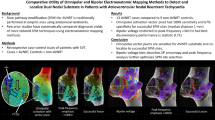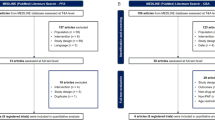Abstract
Recent reports have suggested that transvenous cardioversion ofatrial fibrillation is feasible using low-energy shocks and a right atriumcoronary sinus electrode configuration. We evaluated in a prospective studythe efficacy and safety of low-energy internal cardioversion of atrialfibrillation in 104 consecutive patients. Sixty-two patients presented withchronic atrial fibrillation (group I), 16 had paroxysmal atrial fibrillation(group II), and 26 had an induced atrial fibrillation episode (group III).The mean duration of the presenting episode of atrial fibrillation was 9± 19 months for group I, 4 ± 2 days for group II, and 18± 7 minutes for group III. Atrial defibrillation was performed usingtwo intracardiac catheters: one was placed in the right atrium (cathode) andthe other in the coronary sinus or in the left branch of the pulmonaryartery (anode). The catheters were connected to a customized externaldefibrillator capable of delivering 3/3-ms biphasic waveform shocks with avoltage programmable between 10 and 400 volts. The shocks were synchronizedto the R wave. Sinus rhythm was restored in 44 of the 62 patients in group I(70%), in 12 of the 16 patients in group II (75%), and in 20of 26 patients in group III (77%). The mean voltage and energyrequired for cardioversion were respectively 300 ± 68 V and 3.5± 1.5 J, for group I, 245 ± 72 V and 2.0 ± 0.9 J forgroup II, and 270 ± 67 V and 2.6 ± 1.2 J for group III. Theleading-edge voltage required for sinus rhythm restoration was significantlyhigher (p < 0.05) in the chronic atrial fibrillation group than in theparoxysmal or induced groups. No proarrhythmic effects ocurred for thedelivered 686 R-wave synchronized shocks. This study of a large group ofpatients confirms and extends the results of previous reports. Such findingsmay have clinical implications for elective cardioversion of atrialfibrillation and the development of an implantable atrial defibrillator.
Similar content being viewed by others
References
Lown B. Electrical reversion of cardiac arrhythmias. Br. Heart J 1967;29:469–489.
Lévy S, Lacombe P, Cointe R, Bru P. High energy transcatheter cardioversion of chronic atrial fibrillation. J Am Coll Cardiol 1988;12:514–518.
Lévy S, Lauribe P, Dolla E, et al. A randomized comparison of external and internal cardioversion of chronic atrial fibrillation. Circulation 1992;86:1415–1420.
Chauvin M, Koenig A, Theolade R, Brechenmacher C. La place du choc électrique interne dans le traitement de la fibrillation auriculaire permanente: résultats préliminaires à propos de 28 cas. Arch Mal Coeur 1991;84:377–382.
Lévy S, Ricard Ph, Guenoun M, et al. Low energy internal cardioversion of spontaneous atrial fibrillation: immediate and long-term results. Circulation, in press.
Cooper RAS, Alferness CA, Smith WM, et al. Internal cardioversion of atrial fibrillation in sheep. Circulation 1993;87:1673–1686.
Keane D, Sulke N, Cooke R, et al. Endocardial conversion of atrial flutter and fibrillation (abstract). PACE 1993;16:928.
Johnson EE, Yarger MD, Wharton JM. Monophasic and biphasic waveforms for low energy internal cardioversion of atrial fibrillation in humans (abstract). Circulation 1993;17:1067–1078.
Lévy S, Ricard Ph, Lau CP, et al. Multicenter low energy transvenous atrial defibrillation (XAD) trial results in different subsets of atrial fibrillation. J Am Coll Cardiol 1997: 29:750–5.
Alt E, Schmitt C, Ammer R, Coenen M, et al. Initial experience with intracardiac atrial defibrillation in patients with chronic atrial fibrillation. PACE 1994;17:1067–1078.
Murgatroyd F, Slade AKB, Sopher M, Rowland E, Ward DE, Camm J. Efficacy and tolerability of transvenous low energy cardioversion of paroxysmal atrial fibrillation in humans. J Am Coll Cardiol 1995;25:1347–1353.
Ayers GM, Alferness CA, Ilina M, et al. Ventricular proarrhythmic effects of ventricular cycle length and shock strength in a sheep model of transvenous atrial defibrillation. Circulation 1994;89:413–422.
Lévy S, Ricard Ph. Is there any indication for an intracardiac defibrillator for the treatment of atrial fibrillation? J Cardiovasc Electrophysiol 1994;5:982–985.
Author information
Authors and Affiliations
Rights and permissions
About this article
Cite this article
Socas, A.G., Ricard, P., Taramasco, V. et al. Transvenous Cardioversion of Atrial Fibrillation using Low-Energy Shocks. J Interv Card Electrophysiol 1, 125–129 (1997). https://doi.org/10.1023/A:1009751031170
Issue Date:
DOI: https://doi.org/10.1023/A:1009751031170




